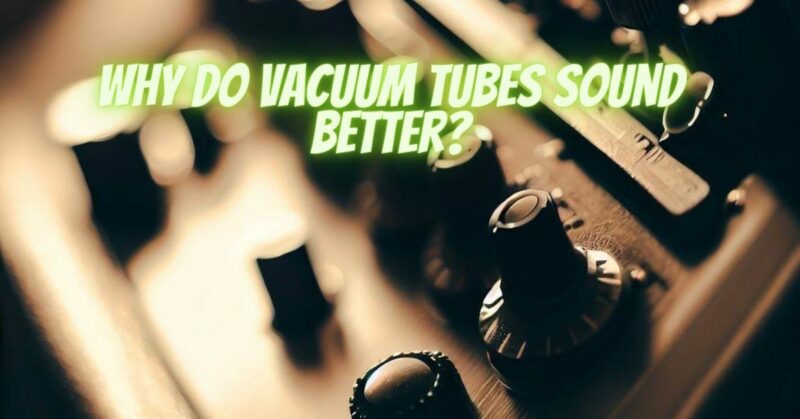Vacuum tube amplifiers, often referred to as tube amps or valve amplifiers, hold a special place in the hearts of audiophiles and musicians. Their warm, rich, and often described as “better” sound quality has earned them a dedicated following. In this article, we will explore the factors that contribute to the perception of vacuum tubes sounding better, delving into the science and characteristics that make tube amplifiers unique.
- Harmonic Distortion:
One of the key reasons vacuum tubes are prized for their sound quality is their ability to produce harmonic distortion. Unlike solid-state amplifiers, which often aim for perfect linearity, tubes add harmonics to the signal in a musically pleasing way. These harmonics create a warm and rich tone that many listeners find appealing.
- Soft Clipping:
Tube amplifiers exhibit a form of distortion known as soft clipping when driven to their limits. This means that as the input signal level increases, the distortion gradually increases in a smooth and natural manner. This contrasts with the harsh and abrupt clipping that solid-state amplifiers can produce when pushed beyond their limits.
- Dynamic Range:
Tube amplifiers are renowned for their excellent dynamic range. They can faithfully reproduce both the quietest and loudest passages in music with finesse. This characteristic is especially appreciated in genres like classical and jazz where dynamic range is crucial.
- Non-Linear Response:
Vacuum tubes have a non-linear response to input signals. This non-linearity means that they amplify different parts of the signal in varying degrees. This non-linear response contributes to a more musical and natural tonal balance.
- Second-Order Harmonics:
Tubes primarily generate second-order harmonics, which are considered more musical and pleasing to the human ear than higher-order harmonics. This emphasis on second-order harmonics contributes to the warm and inviting sound of tube amplifiers.
- Smooth Frequency Roll-Off:
Tube amplifiers typically exhibit a smooth frequency roll-off as they approach their maximum output, as opposed to the sharp cutoff seen in solid-state amplifiers. This characteristic allows tube amps to handle transients gracefully and contributes to their natural sound quality.
- Natural Compression:
When driven hard, vacuum tubes introduce a natural compression effect to the audio signal. This compression can smooth out the dynamics, enhancing sustain and musicality, particularly in musical contexts.
- Sonic Character:
Different types of vacuum tubes have unique sonic characteristics. For example, EL34 tubes are known for their tight bass response, while 12AX7 tubes are favored for their smooth midrange. This allows users to tailor their sound to their preferences.
- Aesthetic Appeal:
The visual appeal of vacuum tube amplifiers, with their exposed tubes and intricate circuitry, adds to their desirability. Audiophiles often appreciate not only the sound but also the aesthetic experience of tube amplifiers.
The allure of vacuum tube amplifiers lies in their unique sonic characteristics, including harmonic distortion, soft clipping, dynamic range, non-linear response, and natural compression. These qualities contribute to the perception that vacuum tubes sound better, particularly in contexts where warmth, musicality, and natural tonal balance are highly valued. While solid-state amplifiers have their merits, the mystique of tube amplifiers endures as a testament to the enduring appeal of vintage technology in the world of high-quality sound reproduction.


